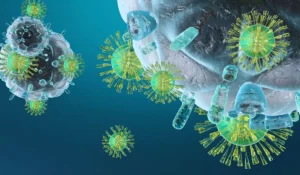What is Von-Hippel Lindau disease?
Von-Hippel Lindau disease is a genetic condition in which there is development of tumor in pancreas, kidneys, adrenal glands and CNS. This disease affects all people regardless of the origin or ethnicity.
Von-Hippel Lindau disease is characterized by mutation of the VHL gene. VHL gene is a tumor suppressor gene found on the short arm of chromosome 3. It codes for Von-Hippel Lindau tumor suppressor protein which break down or degrade hypoxia-inducible transcription factor or HIF and remember, HIF upregulates genes that code for platelet-derived and vascular endothelial growth factors that promote angiogenesis or new blood vessel formation and cell growth.
- What is Von-Hippel Lindau disease?
- What happens when the above mentioned VHL gene is mutated?
- Occurrence and inheritance of VHL disease
- What’s the most common tumor associated with VHL disease?
- Less common tumors associated VHL disease
- What is the treatment of Von-Hippel Lindau Disease?
- Quick summary
- Reference
- Related Articles
What happens when the above mentioned VHL gene is mutated?
It increases HIF, platelet-derived and vascular endothelial growth factors, and that all together elevates the chances of formation of tumor.
Occurrence and inheritance of VHL disease
It is present in 1 in 36,000 people and is as common as Huntington Disease. It is an autosomal dominant disease and because of that, a VHL patient has a 50% chance of passing it on to each kid they have.
Also, 20% of the affected individuals have new mutation or de novo mutation which implies they tend to be the first Von-Hippel Lindau disease patient among the family.
What’s the most common tumor associated with VHL disease?
It’s Hemangioblastoma which is a benign blood vessel tumor that happens in around 60% of VHL patients.
Hemangioblastoma can occur in the retina, brain and spinal cord in the central nervous system. It causes blindness in the eye due to retinal detachment.
Within the central nervous system that is the brain and spinal cord; a tumor or the associated cyst becomes problematic when it presses against the neighboring organs or tissue.
For instance, a tumor within the cerebellum results in ataxia or loss of balance. While headache, nausea and vomiting occurs when the tumor inhibits the cerebrospinal fluid flow as there is increase in intracranial pressure.
Less common tumors associated VHL disease
They are benign cysts and cysts like tumors referred to as Cystadenomas. Endolymphatic sac tumor of the inner ear occurs in around 25% of the Von-Hippel Lindau disease affected individuals. This results in deafness.
For women, Cystadenomas develops in the broad ligament while, for men, it is found in the epididymis.
While for both men and women, there are incidental cysts that are seen in liver, lung, kidney and pancreas
Also, note that certain tumors linked with Von-Hippel Lindau disease are cancerous. Eg is Clear Renal Cell Carcinoma or RCC that occurs in about 60% of the VHL patients’ both kidneys. Then there are pancreatic neuroendocrine tumors that are seen in around 15% of Von-Hippel Lindau disease affected people which have the ability to metastasize.
The two other benign endocrine tumors seen in VHL patients are Pheochromocytomas in adrenal glands and Paragangliomas, which is very similar like pheochromocytoma but form outside the adrenal gland.
These occur in around 20% of the VHL patients. These tumors pump catecholamines like epinephrine and norepinephrine, leading to the signs of sympathetic overactivity such as headaches, sweating, hypertension and palpitation. And, when levels of catecholamines are way too high, there is an occurrence of what is called the “pheo crisis” and this can be fatal.
Generally, Von-Hippel Lindau disease affected patients have their first lesion in their mid-twenties, but onset depends on the type of lesion. I.e. Hemangioblastomas occur earlier in life than renal cell carcinomas. VHL patients develop at least one lesion during their lifetime, but it’s not necessary that they develop all types of VHL lesions.
Also, another scary aspect is new lesions tend to occur in the same organs which already had lesions and because of this, routine monitoring is very important for a healthy life!
What is the treatment of Von-Hippel Lindau Disease?
Therapy is aimed at preserving the organ function and also depends on the type of tumor.
For instance, if you surgically eliminate renal cell carcinoma every time it develops, even when it is minute and asymptomatic, VHL affected individuals may rapidly require dialysis. Surgery is only advised when the tumor is at least 3 cm of length as there are high chances of cancer being metastasized to other locations.
However, retinal hemangioblastomas, should be treated immediately after they are identified, because each laser treatment doesn’t lead to appreciable vision loss.
Quick summary
Von Hippel Lindau disease is an autosomal dominant genetic condition caused by mutation in the VHL gene found on chromosome number 3. This results in increased levels of HIF, platelet-derived and vascular endothelial growth factors, causing tumor development.
The main characteristic feature of Von-Hippel Lindau disease disease is the development of tumors across different organs namely eye, ears, pancreas, adrenal glands, brain and spinal cord. Most of the VHL tumors are benign. However, some other tumors like bilateral clear renal cell carcinoma and pancreatic neuroendocrine tumors have the ability to metastasize to other locations.
Regular monitoring and careful management is critical as Von-Hippel Lindau disease is exceptionally penetrant and repeated lesions can happen during a person’s lifetime.
Reference
Encyclopedia of Molecular Mechanisms of Disease by Florian Lang
Encyclopedia of Molecular Biology by Thomas E. Creighton
Rare Diseases: Integrative PPPM Approach as the Medicine of the Future from Springer







